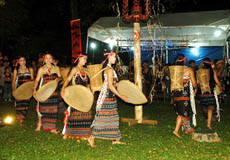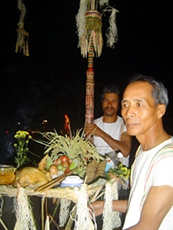In early June, Churu ethnic minority people in the central highland province of Lam Dong are busy with preparations for Mnhum Yang Potai. This is a traditional ceremony to worship the rice goddess.
 In front of a wooden house in Proh commune, Don Duong district, several men are sharpening bamboo poles and decorating them with flowers made from the same materials. Sweat keeps running down their brown faces but none of them give a hoot.
In front of a wooden house in Proh commune, Don Duong district, several men are sharpening bamboo poles and decorating them with flowers made from the same materials. Sweat keeps running down their brown faces but none of them give a hoot.
It is rather hot at this time of year. The sun shines hard on the ground, bringing summer’s throbbing heat to the air with the soft scent of wildflowers and plants from everywhere.
Ya Hang, a 53-year old villiger says: “The Churu, an ethnic minority group in Lam Dong, believe rice has a soul and the rice genie is a goddess. They have a total of nine sacred rituals related to farming practicesâ€.
Here in the community, he adds, only married men are entitled to take care of making two bamboo poles.
The short one, called the female, is decorated with three circles of bamboo flowers, dyed red, black and yellow. Red symbolises human sweat, blood, and energy needed to grow rice. Black symbolises natural calamities, which may create havoc for farmers anytime. Yellow symbolises golden rice arriving home.
The long one, the male, has nine circles of similar flowers. On top of this pole sits a sacred bird named the Polang. It is the bird of God, which can drive away other birds and crows.
The local holyman Ya Phu is regarded as the centre of power. Villagers believe that he can communicate with the gods and evil spirits.
This middle-aged man is a farmer like other villagers. He is invited to perform ancient rituals. At the end of each performance, he is offered a chicken, some wine and a string of beads in return for his assistance.
The two bamboo poles are erected in front of a hut made of bamboo and straw before darkness falls. It is the time the holyman is expected to arrive. He wears a white skirt, his head wrapped around with a long white scarf. He is followed by a man holding a tray of offerings, two men handling a set of three gongs and other people carrying big jars of wine.
In the hut, the villagers put plates of food in the east direction and set the gongs against the wall in the opposite direction. They all believe the east breeds human life that needs the offerings including rectangular cakes, chicken, pork, betel and areca, boiled eggs, rice gruel and bananas. Always added to these things is a bowl of rice gruel with a chicken’s feather stuck in it.
The cakes, made of glutinous rice and beans and wrapped in banana leaves, are tied in pairs, then boiled for four hours.
The sacrificed pig must be a male one of 30kg selected from their roaming pigs. After it is washed clean and tied to a bamboo pole, the butcher will fill up a wine jar with water from a nearby stream, and then pour the wine over the pig’s head before killing it.
In the hut, the holyman burns some wax in a bowl of hot coal – which is supposed to invite the gods to come.
He sits facing east, asking the gods to allow them to start the ceremony. The village elders take their seats behind him.
Ya Phu holds a string from which small bells are hung, with the other end tied to the bamboo partition. While praying, he shakes the string. Sometimes he pulls it strongly, causing the little bells to ring. Sometimes he leans backwards, indicating he is riding a horse to the gods’ world but the ride is rough.
The holyman then informs the gods that the rice has been harvested and taken home, and that the villagers are gathering in the yard to thank them and praying for more bumper crops and good health.
If anything goes wrong during the performance, the holyman has to punish himself by drinking wine or water and hitting himself with a whip.
Two trays of pork are laid out in the yard, while two other trays in the hut are carefully arranged with chicken, rice, wine and a bowl of rice gruel.
A piece of pork is tied above the gongs for the god of gongs.
The holyman holds a bowl of wine in his hands to invite the rice goddess and other gods. When he starts praying, his assistant presents the offerings to the gods.
At the end of the ritual, the holyman throws chicken legs and wings in the air to forecast the future.
“We believe that there are the gods and evil spirits in existence,†says Y Ro Lang A.
The yard where the villagers do the rice threshing, is covered with yellow straw. They make a bonfire and wait till it burns out under the starlit sky.
To the lively accomplishment of their traditional Rokel pan-pipes, drums and gongs, a group of 10 young men and women form an arc and dance.
With graceful hand gestures and glistening eyes, the women perform to invite the gods to come.
Slowly, the dancers approach the hut, their loud cries of delight making the atmosphere very exciting, just like the times when the highland tribes went hunting in the woods.
The panpipe player also falls in step with them. With this Aria dance they all hope to communicate with the gods.
In the meantime, other villagers invite each other to drink their fill out of the jars through straws. In the bright moonlight the merry dancing and drinking will continue until dawn.
"This is the final in a series of rituals to worship the rice goddess," says Toneh Thanh. "We will have to wait until all the families in the commune finish with their next rice crop, to hold this ceremony again.â€